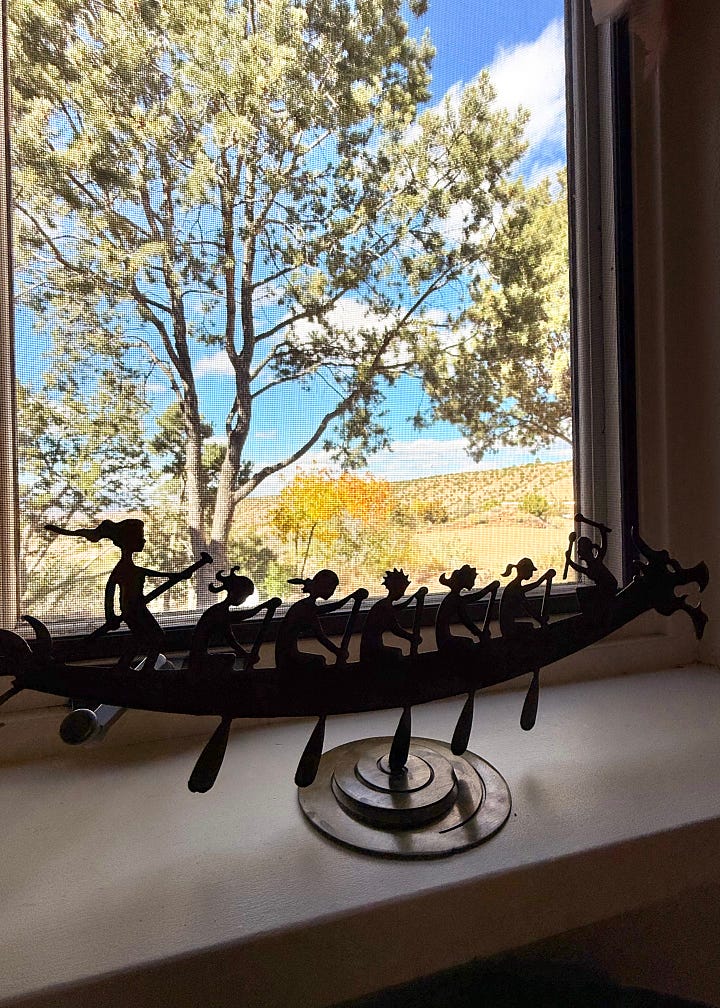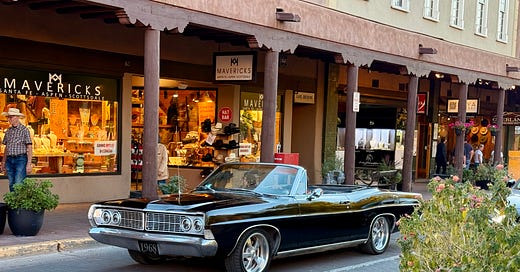

After the main moving crew finished on Friday, two movers—Johnny and Shar—stayed behind to help me unpack. Inadvertently, their larger purpose was to remind me—by example—that every newcomer must respond humbly to land not their own.
A metal dragon boat sculpture that once paddled towards downtown Seattle from my mother’s window now crosses the foothills of the Sangre de Cristo mountains just north of Santa Fe. When Johnny carefully unpacked the rose-gold canoe, these symbolic travelers overlapped with a local story suggesting that they and I tread lightly over newly adopted land.
As a newcomer to New Mexico, I’ve been writing since July about constantly recalibrating my understanding of time and place—a passenger, perhaps on a nomadic symbol now gracing a new window and view.
While the interweaving of the natural landscape, adobe architecture, and long Indigenous and Hispanic cultural traditions may seem like everyday happenstance to those steeped in the American Southwest, my Pacific Northwest roots, tempered by five years overseas, feel driven not only by observation but also by humility and a passion for learning.
Johnny told me almost immediately that his family had been in the area since Santa Fe’s founding in 1610, a surreal genealogical timeline he proudly tied to Spain. He spoke of his grandmother traveling as a girl before paved roads existed, of property prices on the rise, and a critique, I suppose, of people like me.
He offered what felt like a gentle warning drawn from his experiences in the moving business. He described countless clients who visit Santa Fe on vacation, fall in love with its surface beauty and unique atmosphere, and promptly decide to relocate. While this pattern might seem flattering to the City Different style, Johnny revealed consequences to his grandparents that merit some critical thought about an imported NIMBY (not in my backyard) point-of-view.
His grandparents—in their mid-80s— live in a neighborhood his family has called home for generations. Increasingly, they find themselves surrounded by newcomers who express discomfort with their long-standing ways.
Something as simple as front yard parking—a practice that predates zoning laws and, to some, is simple and practical community life—has become a point of contention. Johnny explained that these new neighbors often arrive with rigid preconceptions of how a historic neighborhood “should look,” missing that his grandparents have maintained the practice for years.
My response is to keep my “humility engines” running. Appreciating a place’s surficial beauty is not enough. Genuine appreciation requires a deeper understanding and respect for a place's complex and intermingled ecosystems. I found myself stating with conviction that anyone who arrives only to reject these multiple landscapes—physical, cultural, and historical—has chosen a place for the wrong reasons.
Each day brings fresh discoveries in the Land of Enchantment, but with them comes the responsibility to approach them as a thoughtful participant in a continuing story.






Great perspective!
I appreciate your tread lightly and sensitive listening approach to experiencing new places. Now for the amazing results of what comes of the fusion of cultures/perspectives. I'm hopeful.